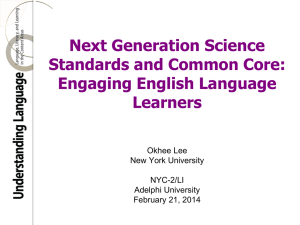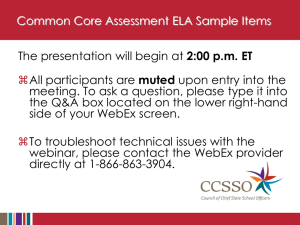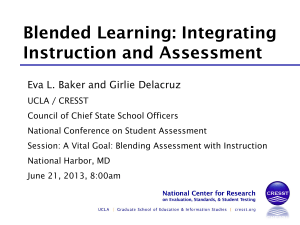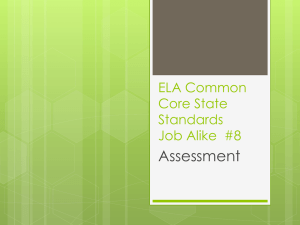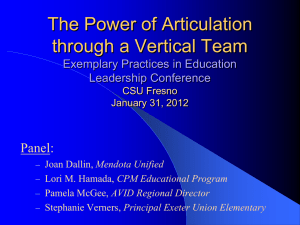Power Point Presentation - Council of Chief State School Officers
advertisement
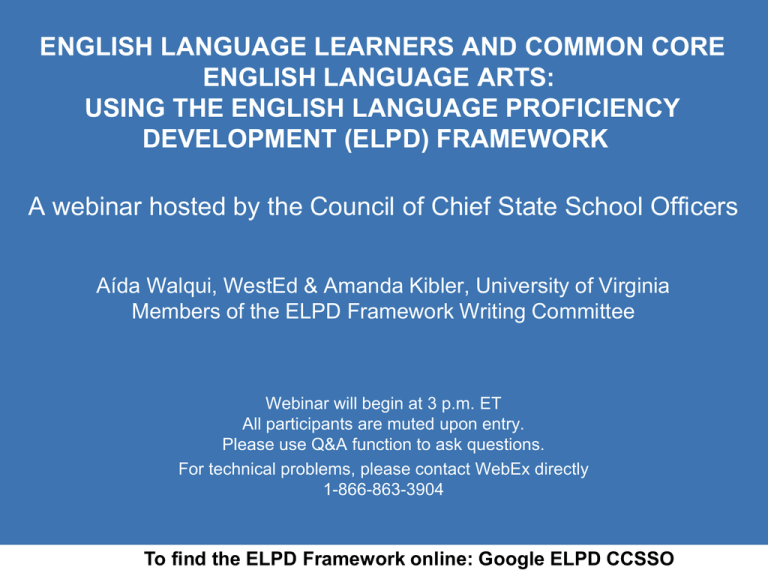
ENGLISH LANGUAGE LEARNERS AND COMMON CORE ENGLISH LANGUAGE ARTS: USING THE ENGLISH LANGUAGE PROFICIENCY DEVELOPMENT (ELPD) FRAMEWORK A webinar hosted by the Council of Chief State School Officers Aída Walqui, WestEd & Amanda Kibler, University of Virginia Members of the ELPD Framework Writing Committee Webinar will begin at 3 p.m. ET All participants are muted upon entry. Please use Q&A function to ask questions. For technical problems, please contact WebEx directly 1-866-863-3904 To find the ELPD Framework online: Google ELPD CCSSO The Focus of Today’s Presentation: Section 2 Today’s presentation will look at: Purpose and Components of the Framework Language Demands and Practices in the CCSS ELA Standards Section 2.3: Standards Match ELA tables begin on page 11 Section 2.4: Classroom Match ELA table is found on page 32 To find the ELPD framework online: Google ELPD CCSSO The Purpose and Vision of the Framework is: To communicate to ELL stakeholders in states the language practices that all ELLs must acquire in order to successfully engage in the CCSSs and NGSSs and to develop English as a second language. To outline the underlying English language practices and uses found in the CCSSs and the NGSS. To delineate a procedure by which to evaluate the degree of alignment present between the framework (which represent the language demands of the CCSS and NGSS) and the ELP standards under consideration or adopted by states. What the Framework does not do: Offer a specific set of ELP standards Spell out what ELLs should be taught Provide a guide for developing assessments Articulate how schools should approach the teaching of English to ELLs Structure of the ELPD • Theory behind ELP standards • The connection to the classroom • The reasoning for sequencing ELP standards Foundation Progressions Classroom Match Standards Match • The connection to the CCSS and NGSS Outline of the Framework There are seven sections in the Framework: Section 1: Introduction to the Framework Section 2: The Framework Section 3: The Alignment Protocol Section 4: Sample Models of Selective ELP Standards Aligned to Framework Section 5: Conclusion Section 6: Glossary Section 7: Supplementary Materials Please note: an overview of the framework was provided on October 11, 2012. To listen to the recording and view the PowerPoint. To find the ELPD framework online: Google ELPD CCSSO A Snapshot of Sections 2.1 and 2.2 of the Framework: Foundations & Progressions Section 2.1: Foundations: explains why state ELP standards should transparently articulate the theoretical foundations upon which they are based. Section 2.2.: Progressions: explains how the ELP Standards should offer a sequence of language development that is grounded in the theoretical foundations for the standards, responsive to the various backgrounds of students, and attuned to the varying language growth trajectories of different ELLs. To find the ELPD framework online: Google ELPD CCSSO Focus on Language Demands: Common Core ELA Reading Standards Students must: Grasp ever-increasing layers of text complexity as they progress through the grades in order to gain deep content understanding (Reading Standard 10) Become increasingly adept at performing a range of difficult practices (involving conceptual understanding, skills, and language), such as: Critically weighing and employing a growing range of evidence drawn from texts Becoming more attuned to discerning nuance, logic, ambiguity, and even inconsistency in an author’s reasoning To find the ELPD framework online: Google ELPD CCSSO Practices: Common Core ELA Writing Standards Students must (continued): Develop the ability to construct narratives as well as written arguments and explanations about what they have read keeping audience and purpose in mind. Write effectively about what they have read using evidence from literary and informational texts To find the ELPD framework online: Google ELPD CCSSO Practices: Common Core ELA Speaking and Listening Standards Students must: Learn important aspects of successful teamwork: listening to one another critically but respectfully while expressing one’s own ideas with increasing specificity and precision Use their oral and aural skills to integrate and evaluate what they see and hear, adapting their interpretation and use of tone, context, and audience contingently. To find the ELPD framework online: Google ELPD CCSSO Practices and a Focus on Language: Common Core ELA Standards English structure: grammar, syntax, mechanical conventions, word meanings Structure runs as a continuous thread throughout all of the standards Students must grow in their ability to utilize these language practices to craft prose and make strategic decisions with regard to the language they employ in varying contexts To find the ELPD framework online: Google ELPD CCSSO Section 2.3: Standards Match “The development of state ELP standards must be undertaken with a deep knowledge of the relationships between the CCSS and the NGSSS and the language practices needed to engage with the content.” Page 6, Section 2.3, Standards Match To find the ELPD framework online: Google ELPD CCSSO Section 2.3: Standards Match This section includes two sets of tables for each discipline (ELA, Math, and Science): The first table notes key practices and disciplinary code ideas of each discipline. The second table unpacks how ELLs engage in these key practices by performing certain analytical tasks through engaging in both receptive and productive language functions. We will review the ELA tables starting on page 11. To find the ELPD framework online: Google ELPD CCSSO Snapshot of ELA Table One (page 11): Table 1: Key Practices and Disciplinary Core Ideas of the ELA CCSS This table outlines: six key CCSS ELA practices the disciplinary core ideas in reading, writing, speaking, and listening, and language The practices outlined here serve as the basis for Table 2, which unpacks these practices into: Analytical tasks Receptive language functions Productive language functions Snapshot of ELA Table Two (starts on page 12): Section 2.4: Classroom Match State ELP Standards should reference the different types of communicative activities embedded in subject matter pursuits, such as: Listening closely Asking questions Engaging in sustained dialogue Arguing claims To find the ELPD framework online: Google ELPD CCSSO Section 2.4: Classroom Match The tables in this section are offered to: Conceptualize the multiple features of students’ and teachers’ language use in the disciplines while engaged in the learning of the key practices in the CCSS and NGSS. Provide a better understanding of what is currently being referred to as academic language and academic literacy Please note that some areas within the tables (e.g. language tasks), are representative and not exhaustive. To find the ELPD framework online: Google ELPD CCSSO Snapshot of ELA Classroom Match Table (Page 32) How to read this table The two major columns of Table 7 suggest unique elements of classroom language for both teachers and students How to read this table The column for student language use and tasks is further subdivided into receptive and productive elements. How to read this table The rows are divided into: Modality Registers Examples of registers First row: Modality The characteristics of the “channels” through which language is used, as in oral and written language versus receptive and productive language skills. Examples include: Communication between individuals in pairs (one-to-one) or small groups (one-to-group) Communication by students or teachers with entire class (one-to-many) Communication by students with various written materials, through oral, written, and multimodal communication. Rows Two and Three: Registers The second row indicates that embedded within modalities are distinct language-related tasks and activities that require unique registers of language: Colloquial registers Classroom registers Discipline-specific language and terminology Disciplinary discourse conventions The third row identifies some of the registers relevant to teachers’ language use and students’ oral and written language use Supplementary Materials: The Understanding Language Taskforce (Valdés, Walqui, Kibler, and Alvarez) developed sample proficiency descriptors supporting the CCSSs and instructional scenarios To find this document online: google ELPD CCSSO Scenarios To find this document online: google ELPD CCSSO Future Webinars Learn more about the Framework! Please visit http://www.ccsso.org/Resources/Digital_Resources/ Common_Core_Webinar_Series.html to register for additional webinars. To find the ELPD framework online: Google ELPD CCSSO Thank you for attending! For questions, please contact: Katey McGetttick CCSSO Program Associate, Common Core kateym@ccsso.org

